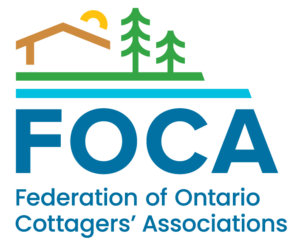
Algae are small, mostly microscopic plants that live in virtually all waterbodies.
There are literally thousands of species of algae that grow in various habitats. They require nutrients and light, and they grow better when it is warm. Algae produce oxygen and convert carbon into organic compounds that feed zooplankton and – in turn – small and larger fish.

Dec. 2, 2024 – Warmer winters are fuelling a growth in algal blooms across the Great Lakes, says University of Waterloo research (The Conversation)
October 2024 – explore a CBC News story map about Toxic Algal Blooms on the Great Lakes and what scientists are developing to protect against them.
In related news, Water Canada reported in late October 2024 that Brock University researchers are investigating potential toxins in Lake Erie algae. Read the online article here.
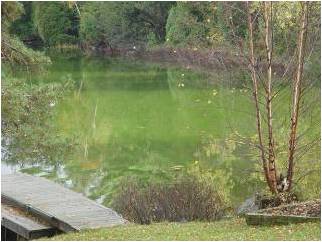
image courtesy J. Winter
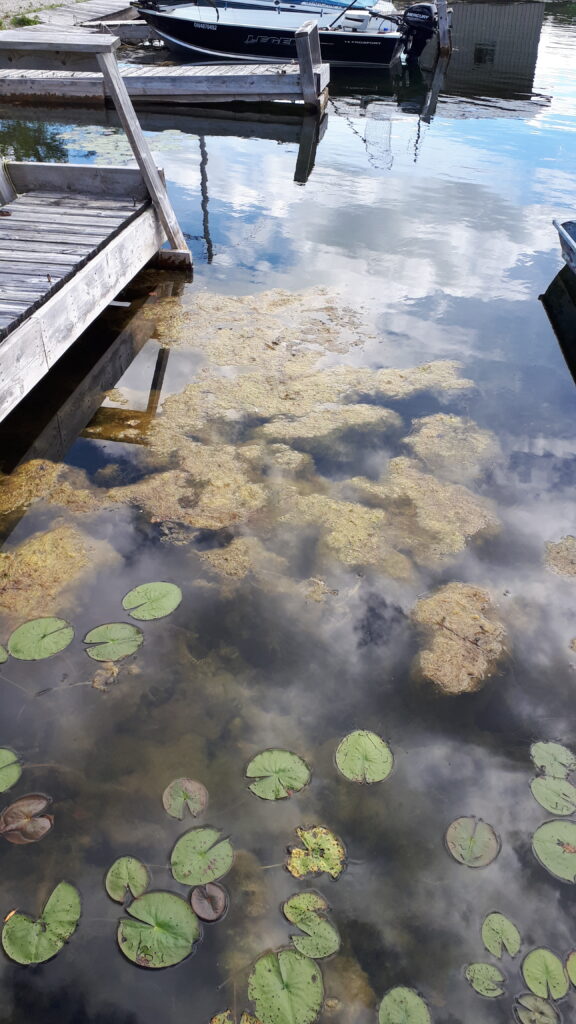
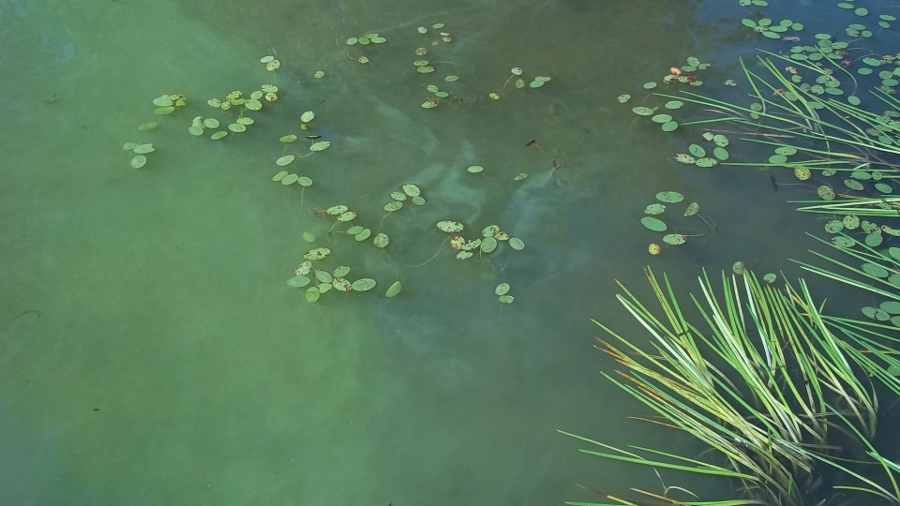
image courtesy Ontario Ministry of the Environment

Algae are an important part of lake ‘food webs’ and a necessary part of ecosystem integrity.
However, some types of algae are toxic to humans and animals, and algal blooms in Ontario waterways are becoming more prevalent.
What should you do if you spot a suspected blue-green algae bloom on a waterbody in Ontario?
Report sighting of possible blue-green algae blooms to the Ontario Ministry of the Environment, Conservation and Parks who will investigate and may take water samples to confirm if the algae is one of the species that produces harmful toxins.
Report possible sightings online here or by phoning the Spills Action Centre at 1-866-663-8477.
Additional tips if you suspect a blue-green algal bloom:
- assume toxins are present
- avoid using, drinking, bathing or swimming in the water (call your local health unit for swimming advisories)
- restrict pet and livestock access to the water
Contact your local health unit for information on health risks associated with blue-green algal blooms.
Earlier News:
September 25, 2024 – watch a partner webinar (posted to YouTube) about harmful algal blooms: what they are, what may contribute to them, what homeowners outside of Source Water Protection zones should do about them, and how scientists are working to find solutions to protect us from them. This webinar is part of the “Drinking Water Webinar Series” brought to you by the Best Practices Eastern Ontario Working Group consisting of Quinte Source Protection Area, Cataraqui Source Protection Area, Mississippi-Rideau Source Protection Region, and Trent Conservation Coalition Source Protection Region.
July 2023 – the Summer edition of the North American Lake Management Association‘s publication LakeLine is now available, and open-access to everyone. The entire edition is devoted to scientific papers about harmful algae blooms.
July 28, 2023 – in related algae news, York University research suggests more algal blooms are likely in Lake Erie as deep-water oxygen levels continue to drop. This can also lead to mass kill-offs of fish, when there is a temperature inversion that sends deep waters devoid of oxygen to the surface. The researchers note that low oxygen levels at the bottom of the lake can produce a chemical environment where phosphorus is released from the sediments – a primary nutrient for algae! Read the Water Canada article online.
Feb.3, 2023 – Cyanobacterial blooms in Ontario, Canada: continued increase in reports through the 21st century (NALMS Lake Reservoir Management publication)

Learn more about algae: the good, the bad, and the ugly
Here is a video about algae and algal blooms, from FOCA’s scientific colleagues at the IISD-Experimental Lakes Area:
~
Scroll down for more about algal blooms, blue-green algae, and the process of eutrophication.
Or, jump directly to related fact sheets and articles from FOCA and our partners.
What is an Algal Bloom?
A ‘bloom’ is the excessive growth of one or more species of algae. Blooms are less likely to occur in deep lakes with lower total phosphorus (TP) levels. Conversely, blooms are most likely to occur in shallow lakes or bays that have moderate to high TP. Blooms may:
- Affect the appearance of water
- Result in unpleasant tastes or odours
- Reduce water clarity
- Colour the lake a vivid green, brown, yellow or red
- Deplete oxygen levels in the water
- Produce toxins that are dangerous to humans or animals.
When do algal blooms occur?
A combination of factors are required to result in the formation of a blue-green algal bloom, including:
- Calm weather
- Strong sunlight
- High air and water temperatures
- Relatively shallow water
- Sufficiently high levels of nutrients (in the water or sediments).
The conditions favouring algal blooms unsually occur from mid-summer to fall in Ontario. However, climate change has been having an effect on algal blooms, extending their growing season to new lengths. Whereas reports during the late 1990s tended to end by September of the year, the trend ten years later was for sightings well into October, and by 2010, the last report came in early December.
Blue-green Algae: beware
Though more prevalent in the late summer and Fall, under the right conditions (including areas with excess nutrients such as phosphorus and nitrogen, warm temperatures and lots of light) Ontario lakes can present with blue-green algae blooms throughout the ice-off season. Therefore it is important to protect yourselves and others from this toxic algae by understanding what to look for and how to report it.
Cyanobacteria, commonly called blue-green algae, are microscopic, plant-like organisms that occur naturally in ponds, rivers, lakes and streams. Although often blue-green, they can also be olive-green or red. Dense blue-green algae blooms may make the water look bluish-green, or like green pea soup or turquoise paint. Very dense blooms may form solid-looking clumps. Fresh blooms often smell like newly mown grass, while older blooms may smell like rotting garbage.
QUESTION:
ANSWER:
Eutrophication explained:
Eutrophication refers to excessive plant and algal growth due to the increased availability of nutrients such as phosphorus and nitrogen. Other factors such as sunlight and carbon dioxide may also contribute to eutrophication, but the impact of increased nutrient inputs is much greater.
For more on eutrophication and the different types of lakes, see page 2 of FOCA’s publication, A Shoreline Owner’s Guide to Healthy Waterfronts. (image excerpt, below)
Eutrophication occurs naturally over centuries as lakes age and are filled in with sediments.
However, human activities can accelerate the rate and extent of eutrophication. Increased phosphorus inputs from sources such as agricultural fertilizers or partially treated sewage are examples of human-induced eutrophication of freshwaters, also called cultural eutrophication. Depending on the state of eutrophication there can be dramatic consequences for aquatic ecosystems such as fish kills and blue-green algal blooms. This reminds us why the Lake Partner Program and citizen science monitoring is so vital to maintaining the health of Ontario’s lakes.
To learn more about eutrophication and the differences between natural versus human-induced eutrophication visit: http://www.lakescientist.com/eutrophication/
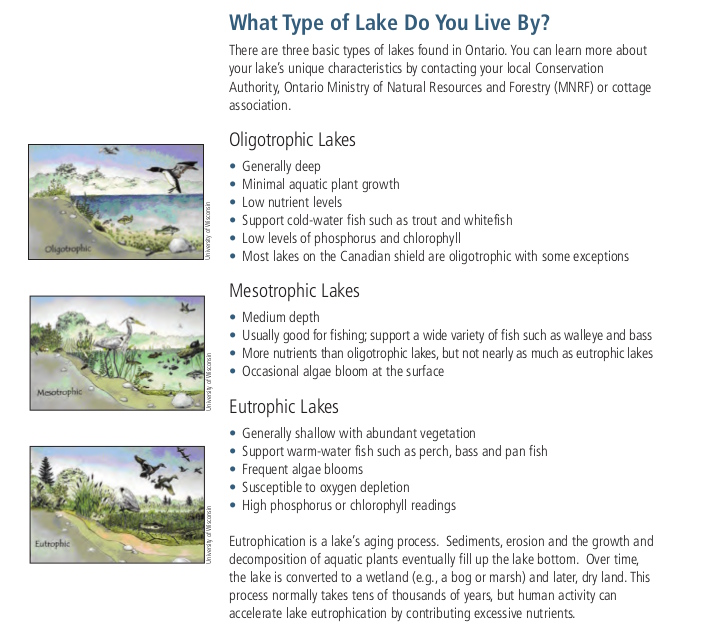
Fact Sheets, Links & Resources:
Download Fact Sheets from FOCA and our partners:
- Algae (PDF, 2 pg)
- Blue-green algae (PDF, 6 pg)
- Blue-green algae & your drinking water system (PDF, 6 pg)
Articles by FOCA and our Partners:
- Cyanobacterial blooms in Ontario, Canada: continued increase in reports through the 21st century by Elizabeth J. Favot et al (2023 Lake and Reservoir Management 39:1, 1-20)
- Under the radar: long-term perspectives on ecological changes in lakes by John Smol (2019; published by the Royal Society, UK)
- Algal blooms in Ontario, Canada: Increases in reports since 1994 by Jennifer Winter et al (2011 Lake and Reservoir Management 27:2, 107-114)
- Algae, the ‘Good’ by Norman Yan, FOCA 2014 Lake Stewards Newsletter (PDF, 1 pg)
- Nuisance Algal Blooms by Liz Favot, FOCA 2017 Lake Stewards Newsletter (PDF, 2 pg)
- Predicting Algal Blooms by Anurani Persaud, FOCA 2016 Lake Stewards Newsletter (PDF, 1 pg)
- Algal Blooms in Ontario’s Lakes by Jennifer Winter, FOCA 2011 Fall Report to Membership (PDF, 3 pages)
Also review these additional partner resources:
- visit the Blue-green algae webpage of the Ontario Ministry of the Environment, Conservation and Parks
- Listen to a 2021 Planet Haliburton radio broadcast about cyanobacteria and lake impacts with FOCA’s colleague, Dr. Liz Favot
- Harmful Algae Blooms Factsheet from Haliburton Kawartha, Pine Ridge District Health Unit
- Algae Blooms in Ontario’s Lakes: Analyzing the trends from a 2011 slide presentation by Jenny Winter, Ministry of the Environment
- Algae Quick Guide from the Muskoka Watershed Council
- Blue-Green Algae Blooms in the Great Lakes from the Ontario Biodiversity Council
- video: Cyanobacteria webinar (New Hampshire Department of Environmental Services, 2021)
- quick video: What causes blue-green algal blooms? by Dr. Todd Howell, Great Lakes Ecologist, MOECC

Please note: the following is archival material, and some links to third-party resources may no longer be active.
For more about FOCA’s work with the Lake Partner Program to monitor Ontario’s lakes for phosphorus and other nutrients, visit FOCA’s Lake Partner Program webpage.
For more about developments in Great Lakes research, visit FOCA’s Great Lakes webpage.
